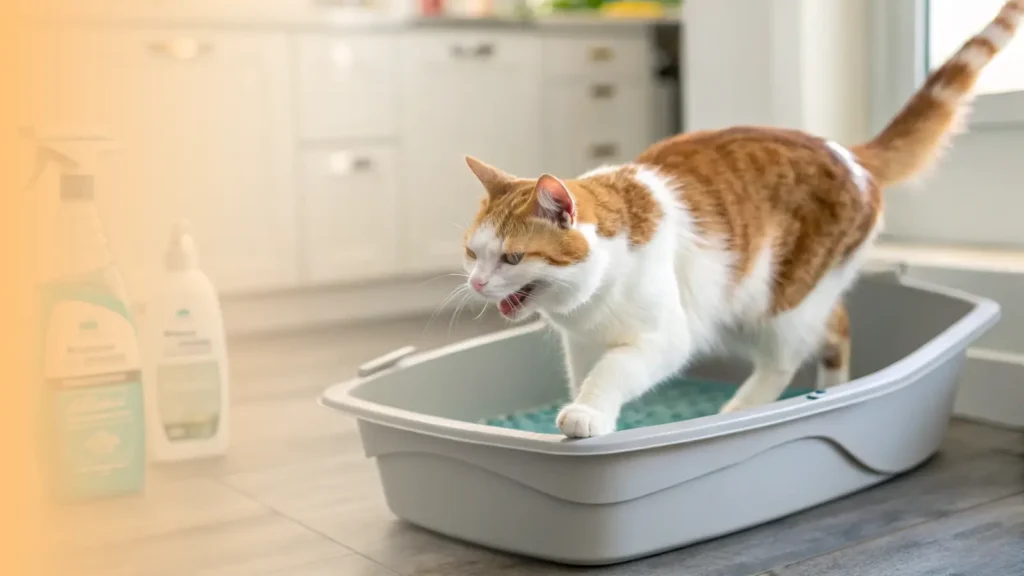When your cat suddenly uses you as a human launchpad, the mix of surprise and sharp claws can be startling. This single act is more than a quirky habit, it is a direct message from your cat, and learning to interpret it can transform your relationship.
In my experience as a cat behavior consultant, understanding the “why” behind the jump is the key to fostering a deeper, more trusting bond.
Why Do Cats Jump on Your Back?
Key Takeaways
- A cat jumps on your back for reasons rooted in deep survival instincts like seeking safety, monitoring territory, and communicating its social status.
- This behavior is often a form of communication, signaling trust, affection, a desire for attention, or the need to mark you with its scent as part of its family.
- It is critical to distinguish between a playful pounce and genuine aggression, as this will determine how you should respond to protect both yourself and your cat.
- Any sudden change in jumping habits, like a reluctance to jump or a new franticness, can be a red flag for an underlying medical issue like pain or illness and requires a call to your vet.
What Instincts Make Cats Want to Be Up High?
This behavior is a modern expression of ancient survival instincts that are hardwired into every cat. From what I’ve observed over years of working with cats, this powerful drive to seek out high places is a fundamental part of who they are. Your back simply happens to be a prime piece of vertical real estate that fulfills several of their core needs.
1. To Feel Safe from Threats
Height equals safety in the feline world. A high perch gives a cat a secure vantage point from which to survey its surroundings, making it feel less vulnerable to being startled by things on the ground.
When your cat gets scared by a loud noise or the vacuum cleaner, leaping onto your back is an instinctive retreat to a trusted, mobile safe zone. In the wild, this same instinct would drive them up a tree to escape a predator.
2. To Watch Over Their Territory
Cats are naturally territorial creatures. An elevated spot allows them to patrol their domain and keep an eye on household activities. By perching on you, your cat is not just getting a good view, it is monitoring its territory from the most important feature within that territory.
I’ve found this act isn’t about dominance over you, but rather a way for the cat to establish a sense of control over its environment, which helps reduce its stress.
3. To Show Their Social Standing
In homes with more than one cat, vertical space is a key resource for keeping the peace. It allows cats to establish their own spaces and avoid conflict. Often, the highest and most desirable perches are claimed by the most confident cat in the group.
A cat jumping onto you, especially when other cats are present, can be a quiet way of asserting its status and its claim to the best seat in the house.
What Is Your Cat Trying to Tell You?
Beyond pure instinct, the act of jumping on you is often a deliberate form of communication. I’ve learned to see these jumps not just as a physical act, but as my cat trying to start a conversation.
The meaning of the message can range from a simple “I love you” to a more calculated “Hey, look at me.”
1. To Show Trust and Affection
A cat jumping onto your back is a significant display of trust and affection. In that position, the cat is making itself vulnerable and placing its safety entirely in your hands. My own cat does this, and I always take it as the ultimate compliment.
It signals a strong bond and shows that the cat feels completely secure with you. Often, it’s a direct request for closeness and shared warmth.
2. To Get Your Attention
Cats are smart and quickly learn what actions get a response. If jumping on your back has previously resulted in getting food, treats, or even just verbal attention, the cat will learn it is an effective strategy. This is a common tactic when you are busy at a desk or trying to relax.
From your cat’s perspective, even a negative reaction like being scolded is still a form of attention, which can accidentally reinforce the very behavior you want to stop.
3. To Mark You With Their Scent
One of the most important reasons your cat jumps on you is to engage in scent marking. A cat’s world is dominated by smell, and when it rubs its cheeks or forehead against you, it is depositing pheromones.
This act, which behaviorists call allorubbing, is not a sign of dominance. In my experience, it’s a profound act of inclusion. The cat is marking you as a safe and essential part of its territory and creating a communal “group scent” that identifies you as family.
Is the Jump Playful or Aggressive?
While most jumps are harmless, it is crucial to be able to tell the difference between an invitation to play and a sign of true aggression. The context of the jump is everything. I always advise my clients to become behavioral detectives and ask not just “What did my cat do?” but “What was happening right before it happened?”
1. Play Aggression
This is the most common type of aggressive behavior directed toward owners, especially in young cats under two years old. Play aggression involves typical hunting behaviors like stalking, pouncing, and batting, but directed at you instead of a toy. The cat’s intentions are playful, but its claws and teeth can still cause injury. A key difference is that the cat’s body language will usually be loose and “bouncy,” not tense and angry.
2. Redirected Aggression
This is a much more serious and dangerous behavior. Redirected aggression happens when a cat becomes highly agitated by something it cannot get to, like an unfamiliar cat outside the window.
Unable to confront the trigger, it redirects that intense aggressive energy onto the nearest target, which is often you.
These attacks can seem to come out of nowhere and are not driven by malice. It is critical to never touch a cat in this agitated state, as it is a prime scenario for a severe bite or scratch.
3. High-Energy Bursts or “Zoomies”
Many owners are familiar with these frenetic random activity periods, or FRAPs. These sudden bursts of energy are a normal way for cats to release pent-up energy, especially for indoor cats who need more stimulation.
While normal, these “zoomies” can lead to a state of overstimulation where play becomes too rough. Learning to recognize this heightened state can help you prevent accidental scratches.
Could a Medical Problem Be the Cause?
Any sudden and significant change in your cat’s behavior should be treated as a potential health alert. I always stress that the first step in addressing a behavioral problem is to rule out an underlying medical cause with a veterinarian. What looks like “bad behavior” is often a cat’s only way of telling you it is in pain or distress.
1. Signs of Pain or Arthritis
Chronic pain is a primary driver of behavioral changes. A cat with a condition like osteoarthritis might still jump on you seeking comfort but then lash out if you accidentally touch a sore joint.
The jump itself might be an attempt to connect, but the aggressive reaction that follows is a clear signal of pain.
2. Reluctance or Inability to Jump
This is a critical red flag that many people miss. A cat that used to love jumping on counters and cat trees but now hesitates or stops jumping altogether is very likely experiencing pain.
Cats are masters at hiding illness, so this change in physical ability is a significant clue that something is wrong and a vet visit is needed.
3. Sudden Increase in Clinginess or Hiding
A sudden increase in how often your cat jumps on you or hides can also signal a problem. If your normally independent cat suddenly becomes a “velcro cat” or starts hiding in high, inaccessible places, it might be feeling ill, anxious, or insecure. It is seeking out a safe zone because it feels vulnerable.
4. Aggression That is Out of Character
A jump that is followed by genuine aggression like hissing, growling, or deep biting from a cat that is normally gentle is a major cause for concern.
Pain-induced aggression is common, and this uncharacteristic behavior is a strong indicator that your cat needs a medical evaluation to find the source of its discomfort.
5. Underlying Illnesses like Hyperthyroidism
Certain diseases can directly impact behavior. For example, hyperthyroidism, an endocrine disorder common in older cats, speeds up their metabolism and can cause hyperactivity and agitation. This can manifest as more frequent and almost frantic jumping.
Similarly, age-related issues like cognitive dysfunction or declining vision can make a cat more anxious, leading to changes in its social behaviors, including jumping.
How to Manage Unwanted Jumping
Once medical causes are ruled out, managing this behavior is about fulfilling your cat’s instincts in a positive way.
The best strategy I have found is not to stop the jumping, but to teach your cat where and when it is appropriate to jump. This approach protects your bond and promotes your cat’s well-being.
1. Provide Approved High Places to Climb
The most effective way to manage unwanted jumping is to enrich your cat’s environment. Provide plenty of appealing vertical spaces like tall cat trees, wall-mounted shelves, and sturdy window perches.
Place these items in socially important areas, like the living room, to make them more desirable than your back or the kitchen counter.
2. Use Positive Reinforcement Training
This is a powerful and humane tool for shaping your cat’s behavior. The idea is simple, you reward the choices you like.
When your cat uses its cat tree instead of your back, immediately give it a high-value treat, praise, or a quick play session. This teaches the cat what you want it to do, rather than just punishing what you do not want.
3. Redirect the Behavior to a Toy
Learn to read your cat’s body language. If you see it getting into that familiar pre-jump crouch, redirect its attention before it launches.
Tossing a favorite toy or bringing out a feather wand can channel that jumping energy into an appropriate and fun game for both of you.
4. What to Do When Your Cat Jumps on You
Your reaction in the moment is crucial. The goal is to teach your cat that jumping on you is unrewarding. Do not talk to it, pet it, or make eye contact.
Simply and calmly stand up so it has to get off, or gently place it on the floor. After a brief moment, you can re-engage with it positively once it is on an appropriate surface, like its cat tree.
5. Why You Should Not Punish Your Cat
Punishing a cat by yelling, spraying it with water, or pushing it away is ineffective and damaging. Punishment teaches the cat to associate fear with you, not with the act of jumping.
This can seriously harm your bond and only makes the cat learn to avoid jumping on you when you are looking, without addressing the underlying instinctual need.
Final Thoughts
A cat jumping on your back is a complex behavior that weaves together instinct, communication, and sometimes, a cry for help.
By understanding the motivation behind the jump, you can respond with empathy and provide what your cat truly needs.
This transforms you from a frustrated owner into an informed partner, strengthening the incredible bond you share.







